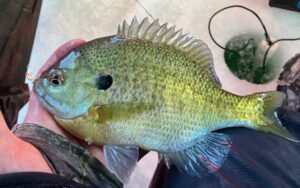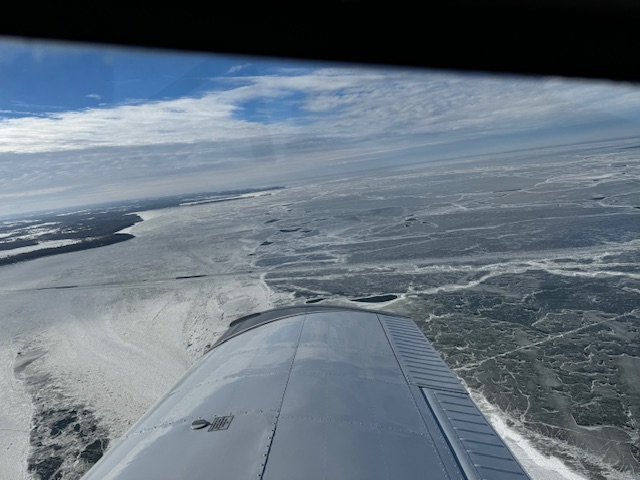The Iceman Finally Cometh.


Seems like I have spent the first portion of this winter season not ice fishing, but fishing for ice. Even as late as Christmas I was still launching my boat into open water rather than dragging my ice shelter onto a frozen lake. (See my Merry Fishmas post.) The mild winter conditions continued into early January leaving even the inland lakes with open water. Waves lapped the shorelines of Lake Michigan and Green Bay where ice would typically have formed. It was not until I returned from a trip to Hawaii that I could consider ice fishing. We spent the first week of January in Maui where the only ice to be found was floating in a cool tropical drink. Pam and I were celebrating our 50th Wedding Anniversary with a visit to the island paradise. At least I was celebrating, I cannot speak for Pam’s reaction to this milestone. Chagrin perhaps. Maui was sunny with warm gentle breezes. This only made our return to Door County all the more shocking. By the time our plane landed at Outagamie County Airport, winter had come to the upper Midwest. Back-to-back snowstorms followed by brutally cold Artic air announced the end of both our vacation and the mild winter. T-shirts and shorts gave way to parkas and heavy boots. The good news was that the lakes were finally starting to freeze.

The physics of liquid water freezing to its solid form is well understood and predictable, in the lab. However, the process of forming a layer of ice over a body of water in a natural environment is much more complicated and very less predictable. We all know, of course, that the freezing point of water is 32°F (0°C), so water in a lake needs to cool down to that temperature before it can freeze. Simple enough. But just because the air temperature is below 32°F, or even a below 0°F, does not mean that a lake will freeze. It takes much longer for water to cool down than air. Water loses its heat much more slowly. If the air stays cold long enough, eventually the water at the surface of the lake will cool down as well. However, water has another trick up its sleeve. As the surface water cools, it increases in density and becomes heavier than the warmer water below it. The cold water sinks, forcing warmer water to the surface which also needs to be cooled to the freezing point. This process repeats, keeping warmer water at the surface well after the air temperatures have dropped. So, for a lake to form a substantial layer of ice, not only does the surface water have to be at the freezing point, but a layer of subsurface water as well. How thick this layer depends upon the size of the lake as well as surface winds and underwater currents. A large lake will contain a lot of warmer water. Waves and currents mix the warm water and the cold water, keeping the surface above freezing well after the air has plummeted below that temperature. This is the reason why very lake lakes, such as Lake Michigan, seldom freeze over, even in the coldest of winters. If none of this sounds familiar to you, you were not paying attention in school. This is physical science 101. Junior high stuff, right between home economics and drivers ed. Wait, no. Oh, never mind. None of this helps if you are trying to find fishable ice. What you need to do is go out and look for it.

That is exactly what I did upon my return from Maui. Even though the bay still had a lot of open water, the inland lakes started to firm up. I tentative drilled holes in Kangaroo Lake testing the ice thickness. How thick the ice needs to be for fishing is a very personal decision. In theory, four inches is plenty for an angler to walk on with a sled. How thick YOU need the ice to be depends upon your level of risk tolerance, how desperate you are to go fishing and how well the fish are biting. Anglers must make their own determination. Occasionally anglers make bad, or at least poorly informed decisions. At best, this results in a wet leg. At worst, it involves the Coast Guard or local search and rescue units. I determined there was sufficient solid ice on the lakes and before long I was putting some nice panfish on the ice.

Last week, ice started to form on the bay. At first, it was only in the sheltered in-shore areas. Tip-ups started to sprout up in Egg Harbor, anglers targeting brown trout cruising the shallow water just under the ice. Then came reports of fish being caught in Sawyer Harbor near Sturgeon Bay and the back end of Little Sturgeon Bay. Wasting no time, I headed down to Potawatomi Park looking for fishable ice. There was plenty. And plenty of anglers as well. Shacks were already spreading off Cabot Point and along the park shoreline. There were even a couple of large air boats cavorting among the groups of anglers. I fished for several hours and all I got was fresh air and exercise. Still, I was on the ice, fishing. Another early ice location is Dead Horse Bay just north of the City of Green Bay off Lineville Road. I had fished Dead Horse a couple of times last season with some success, so I decided that a road trip was in order. As I headed south along Highway 57, I noticed groups of anglers offshore at Dykesville as well as off the point at Bayshore County Park. I can only assume they were over good ice. I’ll keep an eye on the police and fire reports.


Once I arrived at the Dead Horse Bay landing, I had plenty of company. The ice was strewn with scattered groups of anglers. Hauling my Eskimo portable shanty piled high with an electric drill, Vexilar sonar and a pail of shiner minnows, I walked about a half a mile over a sheet of clear, slick ice. Levitating on a layer of ice so transparent that you can see the rocks and weeds below your feet gives you the god-like feeling that you are walking on water. It is both disconcerting and exhilarating. I drilled a set of holes in about ten feet of water and settled in for an afternoon of perch fishing. I had a long wait. After three hours I had only put one of those yellow beauties on the ice. I was about to move, or maybe even call it a day, when my rod bent sharply. Fish on! It was a big Yellow Perch and after a spirited fight, the foot-long fish flopped on the ice. Over the next half hour, I put several more on the ice and lost a few others. At the end of the day, I had a half dozen nice perch. Not a banner day, but enough for a wonderful meal.

So, the ice fishing season has finally started, albeit late. As for getting to the deeper waters of Green Bay in search of those schools of whitefish, that may not be for a while. There is the definite possibility that parts of the bay which were ice covered in previous years, may not have fishable ice at all this season. This impacts not only local anglers but the fishing guides, tackle shops and restaurants that support sport fishing in the winter. Local fish guide, sportsman and all-around good guy, J.J. Malvitz, recently took an airplane ride over Green Bay to assess the ice conditions. What he saw was not encouraging. J.J. reported seeing may areas of open water even in some of the shallow areas of the bay off Door County. The warm conditions forecast for the upcoming week, along with the possibility of rain will not be conducive for ice formation.

Ice conditions on the inland lakes and near shore areas of the bay should stay fishable for now. Perhaps, with some luck and cold weather, the ice sheet will expand and provide more fishable areas. Be patient and cautious. Fishing for ice is not as much fun as ice fishing, but it appears to be our fate this year and perhaps for years to come.
So long and thanks for all the fish, Bruce
Questions or comments to bsmith733@gmail.com


Great article Bruce.
Thoroughly enjoyed it.
Can’t believe you celebrated a 50th.What was Pam when you got married 13? That’s not legal in WI you know.
Honest Joe
Good one bruce!
I learned a lot about how ice forms on lakes also I was impressed with the perch and bluegill on the photo. Florida weather has been good. So far fishing sucks. I will call when I get back